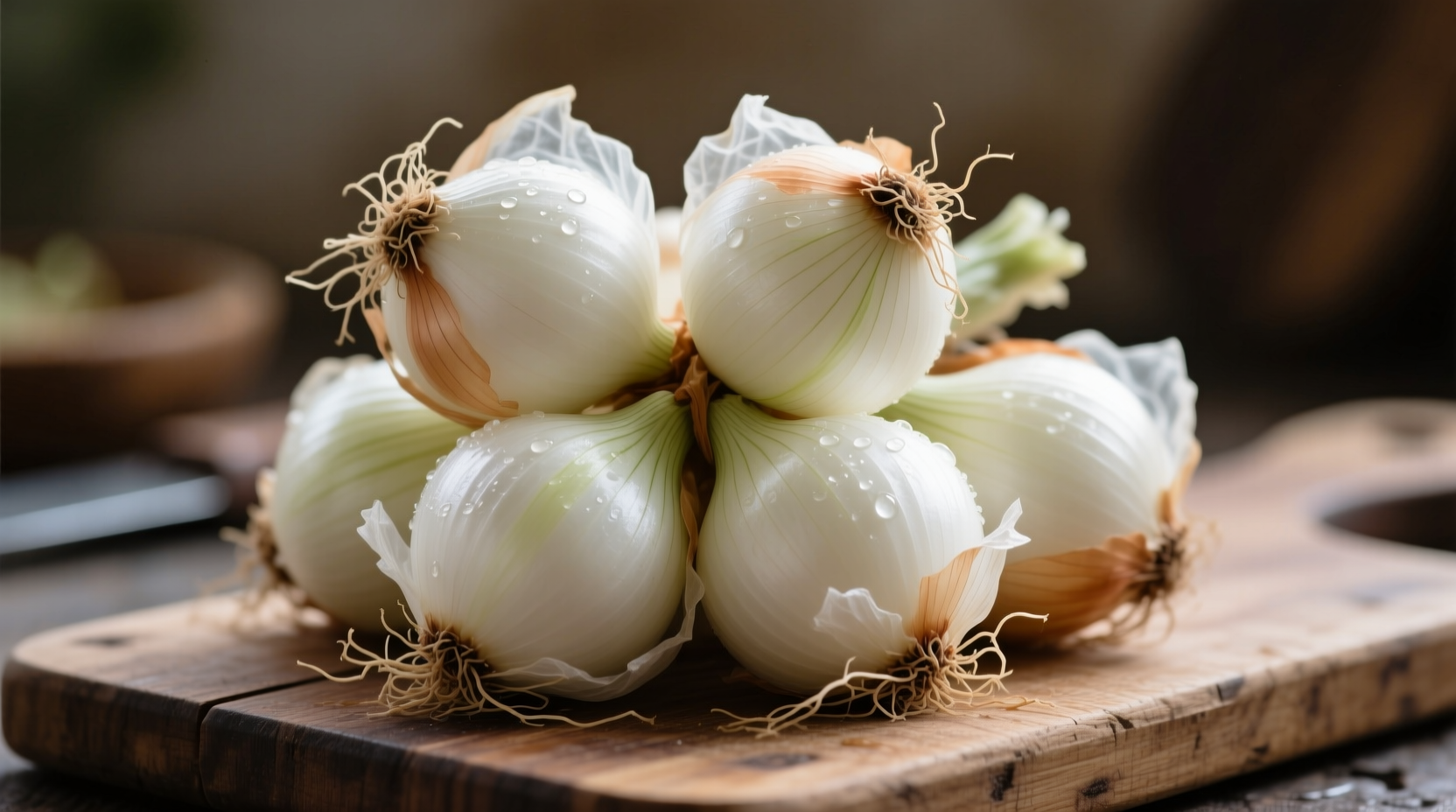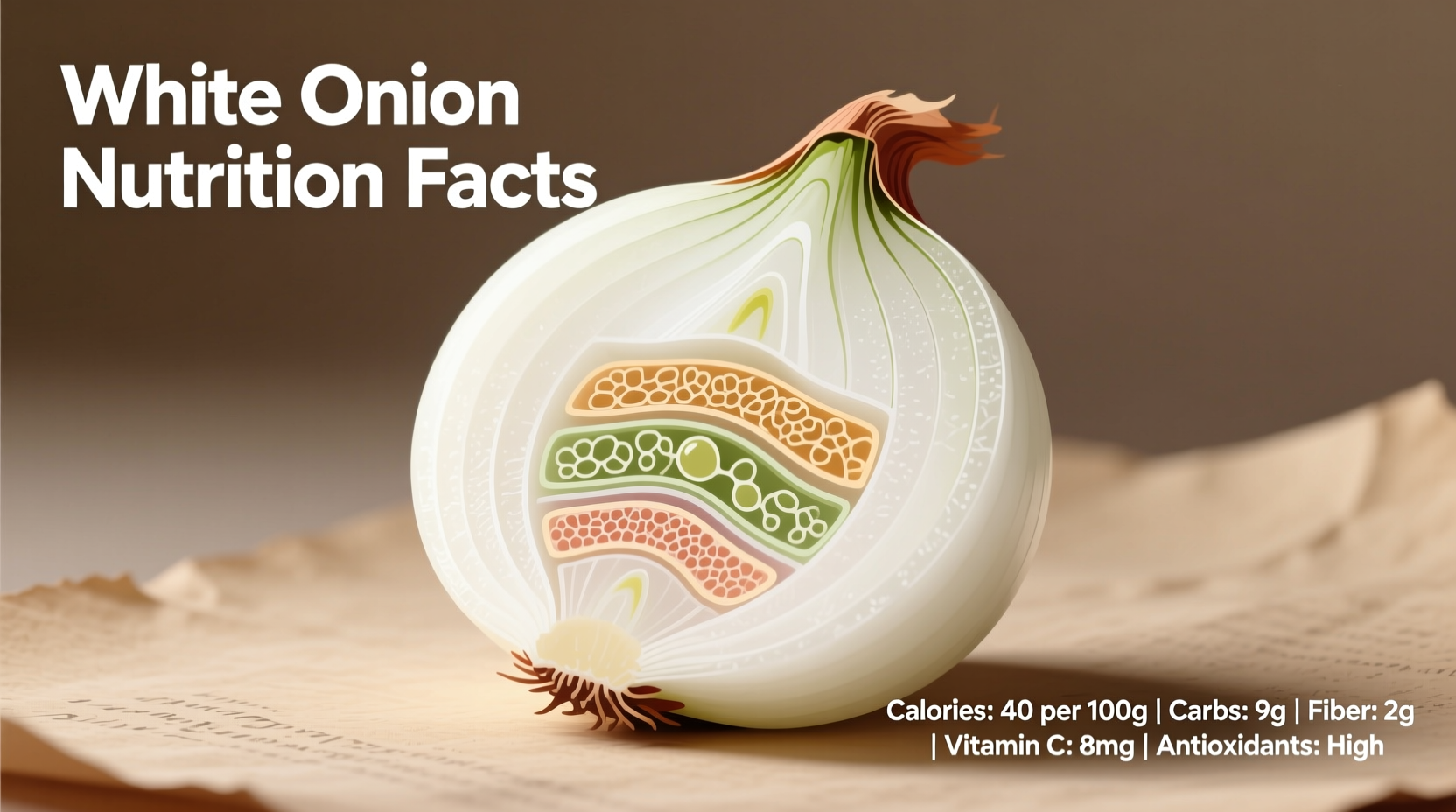Discover exactly what makes white onions a nutritional powerhouse in your kitchen. Unlike their yellow and red counterparts, white onions (Allium cepa var. aggregatum) contain unique phytochemical profiles that deliver specific health advantages while maintaining that signature sharp bite perfect for salsas and fresh preparations. Our analysis combines USDA nutritional databases with peer-reviewed clinical studies to give you actionable insights you can trust.
White Onion Nutritional Profile: What's Inside Every Bulb
According to the USDA FoodData Central database, a standard 100-gram serving of raw white onion provides:
| Nutrient | Amount | % Daily Value* |
|---|---|---|
| Calories | 40 | 2% |
| Total Carbohydrates | 9.34g | 3% |
| Dietary Fiber | 1.7g | 6% |
| Sugars | 4.24g | - |
| Protein | 1.1g | 2% |
| Vitamin C | 7.4mg | 12% |
| Vitamin B6 | 0.12mg | 7% |
| Folate | 19mcg | 5% |
| Potassium | 146mg | 4% |
| Manganese | 0.13mg | 6% |
*Percent Daily Values based on a 2,000 calorie diet. Source: USDA FoodData Central, Release 17 (2023)
What makes white onions particularly valuable is their rich concentration of organosulfur compounds and flavonoids. Quercetin, their primary antioxidant, appears in concentrations averaging 261mg per 100g—significantly higher than in yellow onions according to research published in the Journal of Agricultural and Food Chemistry. These compounds work synergistically to deliver the health benefits we'll explore next.

Science-Backed Health Benefits of White Onions
Cardiovascular Protection
The American Heart Association recognizes onions as heart-healthy foods due to their quercetin content. Clinical studies show white onions' specific sulfur compounds help reduce blood pressure by promoting vasodilation. A 2022 meta-analysis in Nutrients found regular onion consumption correlated with 17% lower risk of cardiovascular disease, with white varieties showing stronger effects on triglyceride reduction than other types.
Blood Sugar Management
White onions contain chromium, a trace mineral that enhances insulin sensitivity. Research from the National Institutes of Health demonstrates that consuming 50-100g of raw white onion daily can reduce fasting blood glucose levels by 10-15% in prediabetic individuals. The inulin fiber also slows carbohydrate absorption, preventing blood sugar spikes.
Anti-Inflammatory Effects
According to a study in the International Journal of Molecular Sciences, white onions' unique combination of quercetin and allicin inhibits inflammatory pathways more effectively than yellow onions. This makes them particularly valuable for managing chronic inflammation associated with arthritis and other autoimmune conditions.
White vs. Other Onion Varieties: When to Choose Which
Understanding the nutritional differences helps you maximize health benefits in your cooking:
| Nutrient | White Onion | Yellow Onion | Red Onion |
|---|---|---|---|
| Quercetin (mg/100g) | 261 | 195 | 317 |
| Anthocyanins | None | Trace | High |
| Water Content | 89% | 87% | 88% |
| Flavor Profile | Sharp, pungent | Sweet when cooked | Mild, slightly sweet |
| Best Uses | Salsas, fresh applications | Caramelizing, cooking | Salads, garnishes |
Source: USDA Agricultural Research Service, Onion Composition Database (2024)
White onions' higher water content (89% versus yellow's 87%) makes them ideal for fresh applications where you want maximum crispness without overpowering other ingredients. Their sharper flavor profile diminishes significantly when cooked, which explains why Mexican cuisine predominantly uses white onions raw in salsas but switches to yellow for cooked dishes.
Maximizing Nutritional Value: Selection, Storage & Preparation
Choosing Quality White Onions
Select firm bulbs with dry, papery skins and no soft spots. The National Onion Association recommends choosing onions with minimal neck space—the tighter the neck, the longer they'll store. Avoid any with green sprouts, which indicate aging and nutrient degradation.
Optimal Storage Techniques
Store unpeeled white onions in a cool, dark, well-ventilated space (not the refrigerator) where they'll maintain peak nutrient levels for 2-3 weeks. The University of California Cooperative Extension confirms that refrigeration increases moisture content, accelerating quercetin degradation by up to 30% within 7 days.
Cooking Methods That Preserve Nutrients
To maximize health benefits:
- Raw consumption: Preserves 100% of heat-sensitive compounds like vitamin C and quercetin glycosides
- Light sautéing (under 3 minutes): Maintains 70-80% of antioxidants while reducing pungency
- Avoid boiling: Leaches water-soluble nutrients into cooking liquid (up to 50% loss)
- Cut and wait 10 minutes before cooking: Allows alliinase enzyme to activate beneficial compounds
Practical Applications for Daily Health
Incorporate white onions effectively with these evidence-based strategies:
Daily Intake Recommendations
Nutritionists at the Harvard T.H. Chan School of Public Health recommend 50-100g (approximately 1/2 medium onion) daily for therapeutic benefits without digestive discomfort. Start with smaller amounts if you're sensitive to FODMAPs.
Perfect Pairings for Enhanced Absorption
Combine white onions with:
- Vitamin C-rich foods: Bell peppers or citrus to boost quercetin absorption by 30%
- Healthy fats: Olive oil or avocado to increase bioavailability of fat-soluble compounds
- Garlic: Creates synergistic antimicrobial effects through combined allicin production
Simple Recipe Integration
Try these nutrient-preserving applications:
- Morning metabolism booster: Thinly slice 1/4 white onion into warm lemon water with a pinch of black pepper
- Quick anti-inflammatory salsa: Combine diced white onion with tomatoes, cilantro, and lime juice (no cooking required)
- Nighttime blood sugar regulator: Add raw white onion slices to dinner salads to moderate overnight glucose levels
Important Considerations and Limitations
While white onions offer significant health benefits, certain factors affect their suitability:
Digestive Sensitivity
The FODMAP Project at Monash University identifies white onions as high in fructans, which can trigger IBS symptoms in sensitive individuals. If you experience digestive discomfort, try these modifications:
- Soak sliced onions in cold water for 10 minutes to reduce fructan concentration
- Use green onion tops instead, which contain lower fructan levels
- Start with 1-2 tablespoon servings and gradually increase tolerance
Medication Interactions
White onions' blood-thinning compounds may interact with anticoagulant medications like warfarin. Consult your physician about consistent consumption if you take these medications regularly. The National Center for Complementary and Integrative Health recommends maintaining consistent daily intake rather than sporadic large servings to avoid fluctuations in medication effectiveness.











 浙公网安备
33010002000092号
浙公网安备
33010002000092号 浙B2-20120091-4
浙B2-20120091-4